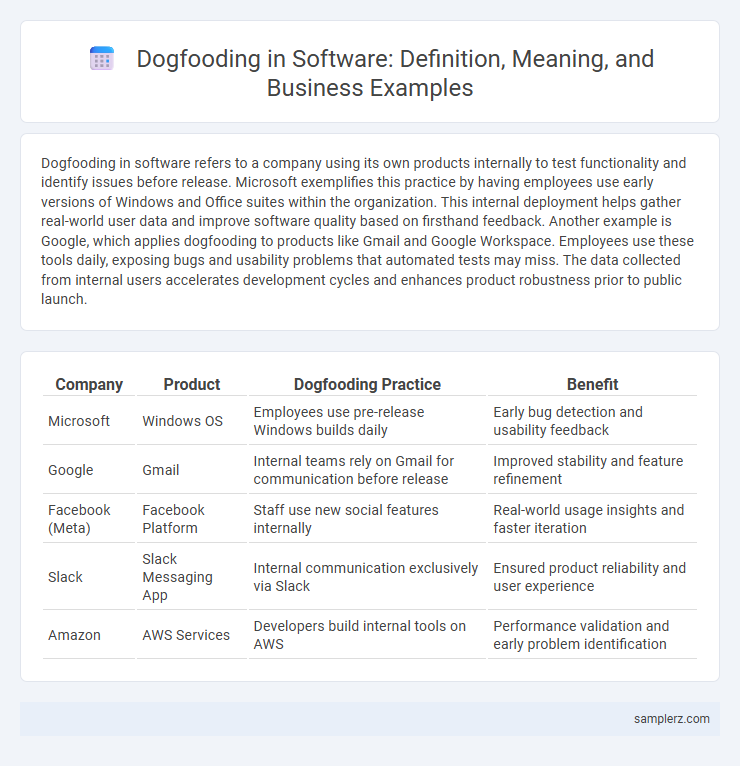Dogfooding in software refers to a company using its own products internally to test functionality and identify issues before release. Microsoft exemplifies this practice by having employees use early versions of Windows and Office suites within the organization. This internal deployment helps gather real-world user data and improve software quality based on firsthand feedback. Another example is Google, which applies dogfooding to products like Gmail and Google Workspace. Employees use these tools daily, exposing bugs and usability problems that automated tests may miss. The data collected from internal users accelerates development cycles and enhances product robustness prior to public launch.
Table of Comparison
| Company | Product | Dogfooding Practice | Benefit |
|---|---|---|---|
| Microsoft | Windows OS | Employees use pre-release Windows builds daily | Early bug detection and usability feedback |
| Gmail | Internal teams rely on Gmail for communication before release | Improved stability and feature refinement | |
| Facebook (Meta) | Facebook Platform | Staff use new social features internally | Real-world usage insights and faster iteration |
| Slack | Slack Messaging App | Internal communication exclusively via Slack | Ensured product reliability and user experience |
| Amazon | AWS Services | Developers build internal tools on AWS | Performance validation and early problem identification |
Understanding Dogfooding in Software Development
Dogfooding in software development involves companies using their own products internally to identify issues and improve functionality before release. Microsoft, for example, extensively employs dogfooding by having employees use early versions of Windows and Office to uncover bugs and enhance user experience. This practice accelerates feedback loops and ensures higher quality software aligned with real-world use cases.
Why Software Companies Practice Dogfooding
Software companies practice dogfooding to identify bugs and usability issues early by using their own products internally before public release. This approach enhances product quality, accelerates innovation cycles, and aligns development with real user experiences. Companies like Microsoft and Google demonstrate that internal testing fosters greater customer satisfaction and reduces post-launch support costs.
Notable Companies Using Dogfooding Strategies
Notable companies such as Microsoft, Google, and Facebook have successfully implemented dogfooding strategies by extensively using their own software products internally before public release. Microsoft's adoption of Windows and Office builds for internal feedback accelerates refinement and innovation, while Google's practice of using early versions of Android and Chrome ensures real-world testing and enhances product reliability. Facebook's internal use of its social media platform allows teams to identify and resolve user experience issues rapidly, resulting in more robust and user-centered software solutions.
Real-World Examples of Dogfooding in Action
Microsoft's use of Windows Insider Program exemplifies effective dogfooding by allowing internal teams and early adopters to test pre-release versions, identifying bugs and providing feedback before public launch. Google applies dogfooding extensively with Gmail and Google Workspace, where employees use new features internally to ensure reliability and usability. Atlassian also practices dogfooding by having its developers rely on its own collaboration tools like Jira and Confluence during product development phases, leading to improved software quality.
Dogfooding in Agile and DevOps Environments
Dogfooding in Agile and DevOps environments accelerates software quality improvement by enabling teams to use their own products internally, leading to rapid feedback and iterative enhancements. This practice fosters collaboration between development, operations, and testing teams by integrating user experience insights early in the delivery pipeline. Continuous integration and continuous deployment (CI/CD) pipelines benefit from dogfooding by exposing real-world issues, reducing bugs, and ensuring smoother releases.
Benefits of Dogfooding for Software Teams
Dogfooding allows software teams to identify bugs and usability issues early by using their own products daily, enhancing product quality and reliability. It fosters a deeper understanding of user experience, driving more empathetic and effective development decisions. Continuous internal testing accelerates feedback loops, reducing time-to-market and ensuring smoother product launches.
Challenges Encountered During Dogfooding
Dogfooding in software development often reveals challenges such as uncovering unexpected bugs that disrupt daily workflows and hinder productivity. Teams may face resistance from employees unaccustomed to using in-house tools, resulting in incomplete or biased feedback. Ensuring consistent adoption across departments requires effective communication and training to mitigate these obstacles and maximize dogfooding benefits.
Measuring the Impact of Dogfooding on Product Quality
Measuring the impact of dogfooding on product quality involves tracking key performance indicators such as defect density, user satisfaction scores, and deployment frequency within the organization. Software teams that practice internal use of their products often report a significant reduction in critical bugs and faster identification of usability issues, leading to improved product stability. Data from companies like Microsoft and Google highlight that dogfooding accelerates feedback loops, enabling continuous improvement cycles and more reliable software releases.
Dogfooding Best Practices for Software Businesses
Successful software businesses implement dogfooding by integrating their latest products into daily operations, enabling real-time user experience feedback from internal teams. Establishing transparent communication channels ensures that developers and stakeholders receive actionable insights to rapidly address bugs and enhance features. Prioritizing regular updates and comprehensive training cultivates employee engagement, ultimately leading to higher software quality and customer satisfaction.
Future Trends in Dogfooding for Software Companies
Software companies increasingly integrate dogfooding with AI-driven analytics to enhance product usability before public release. Embracing cloud-based collaboration tools accelerates feedback cycles and cross-team integration, improving real-time issue resolution. Future trends highlight augmented reality and machine learning as key components in creating immersive internal testing environments for software innovation.

example of dogfooding in software Infographic
 samplerz.com
samplerz.com